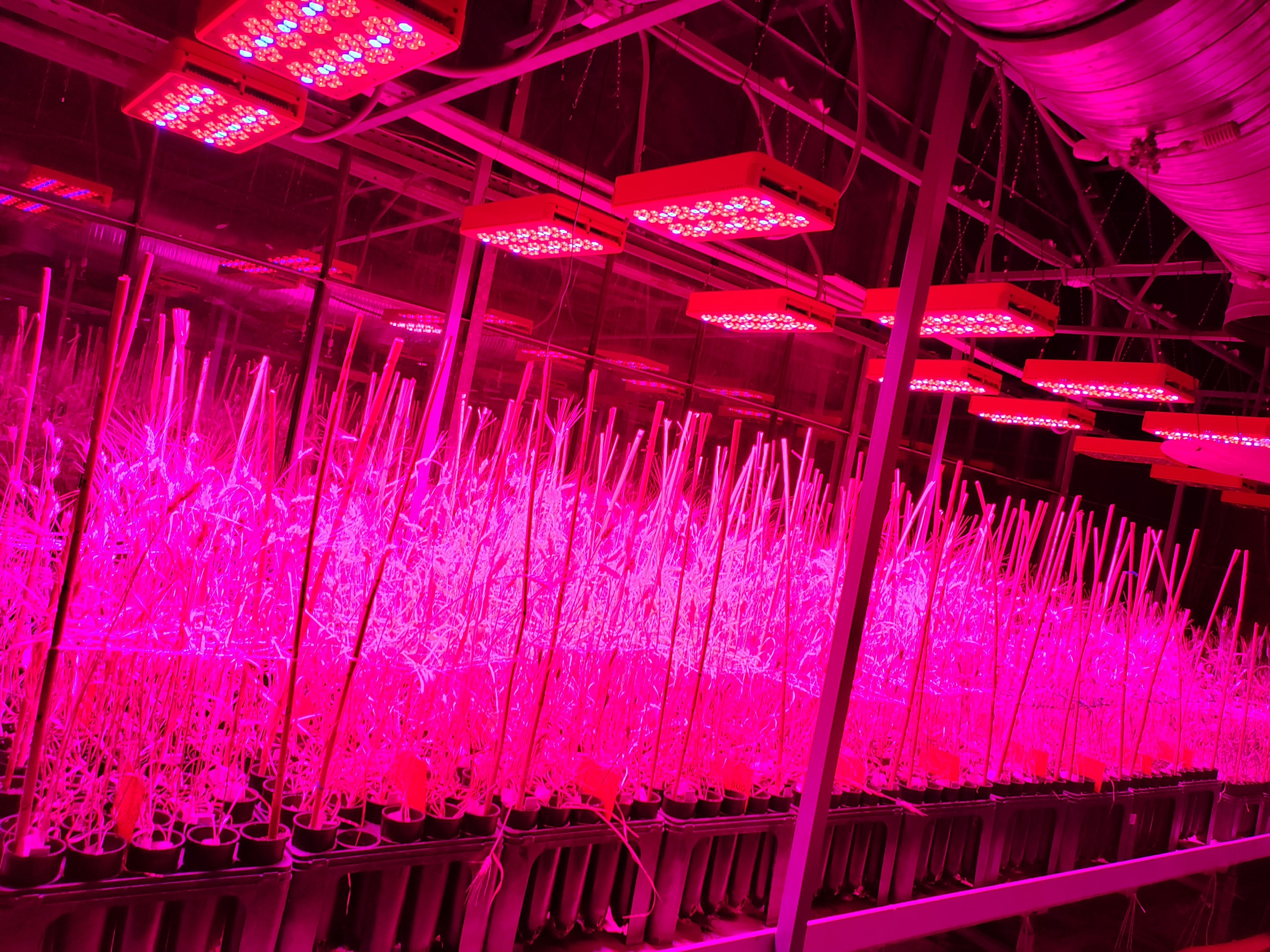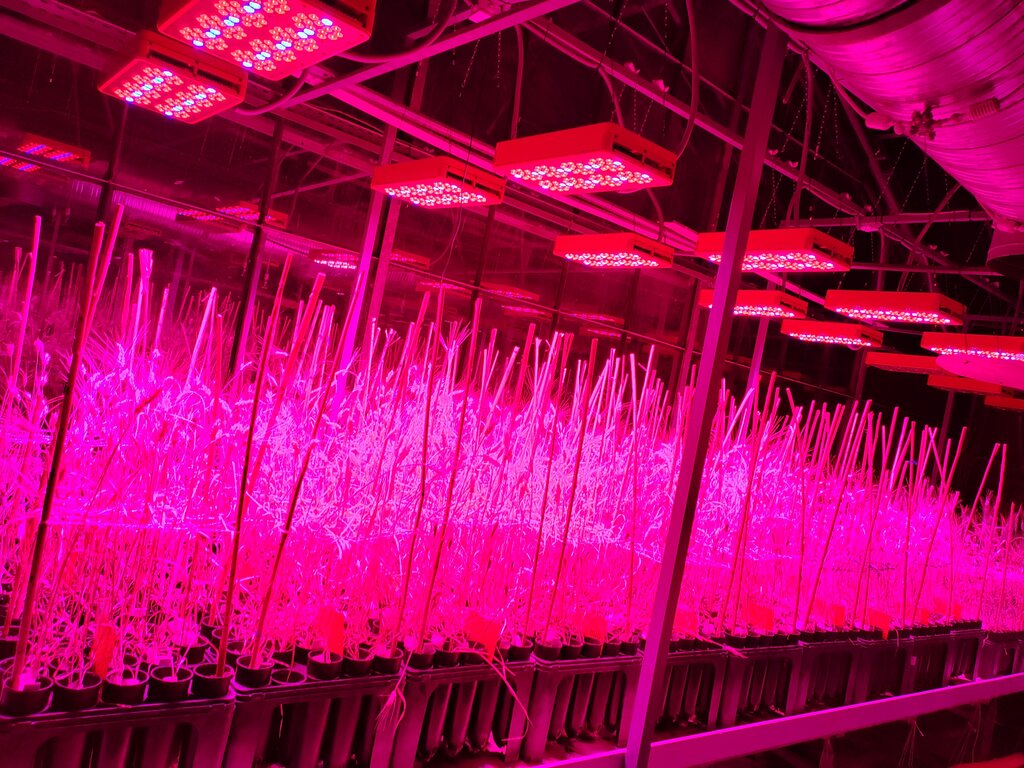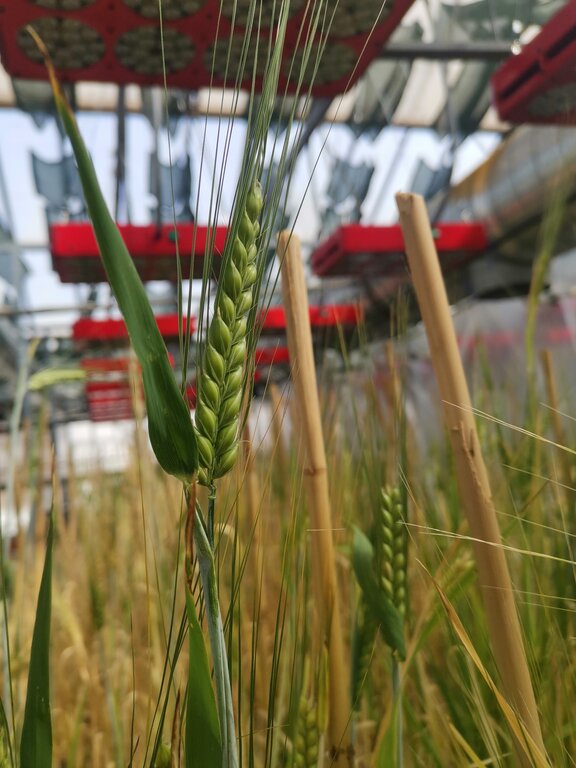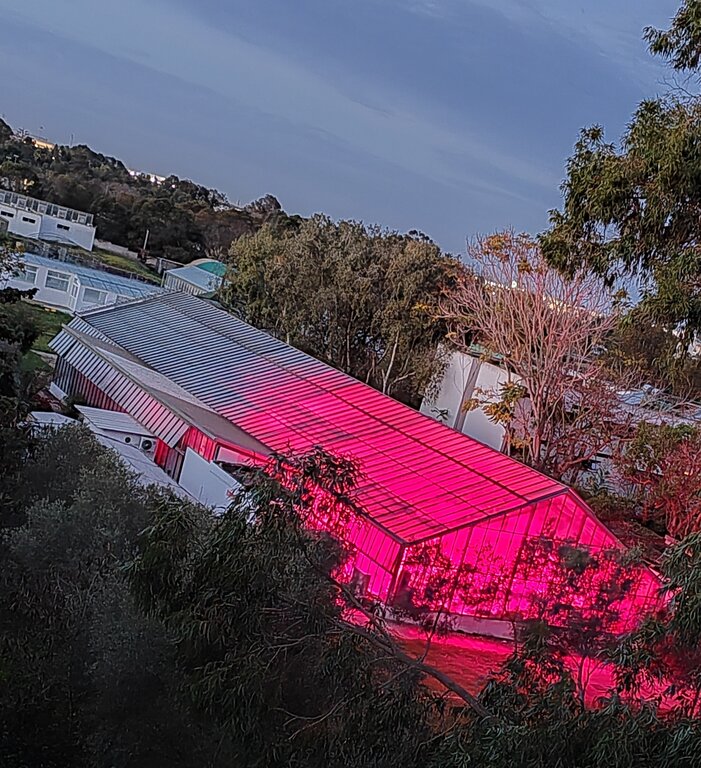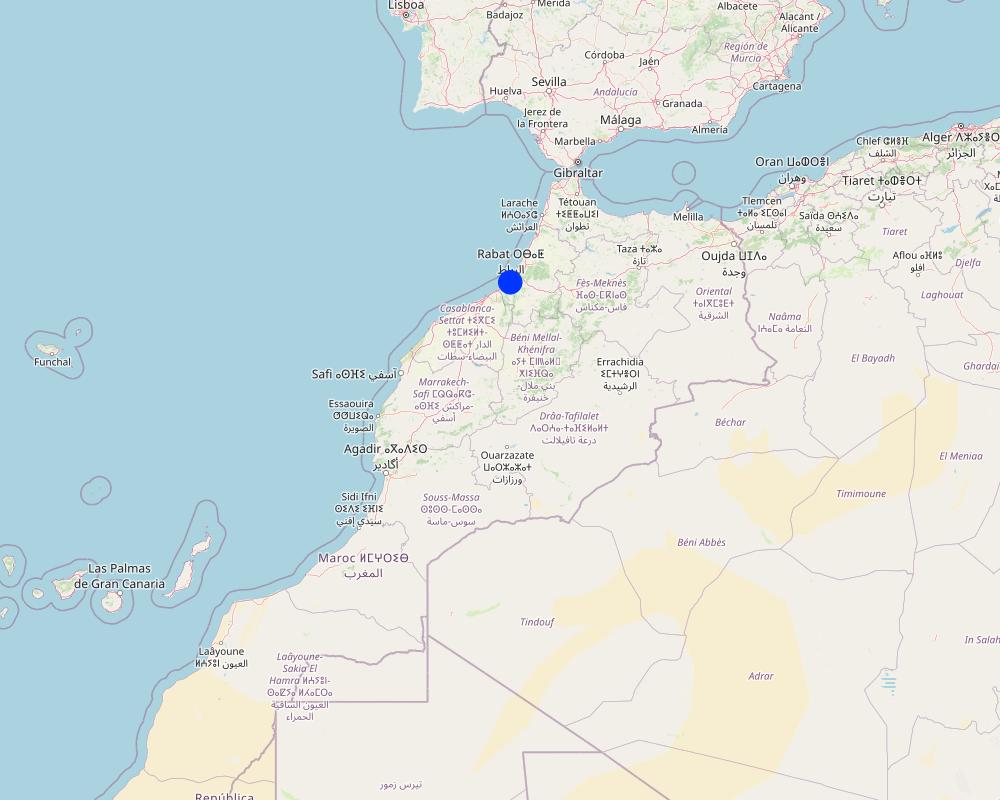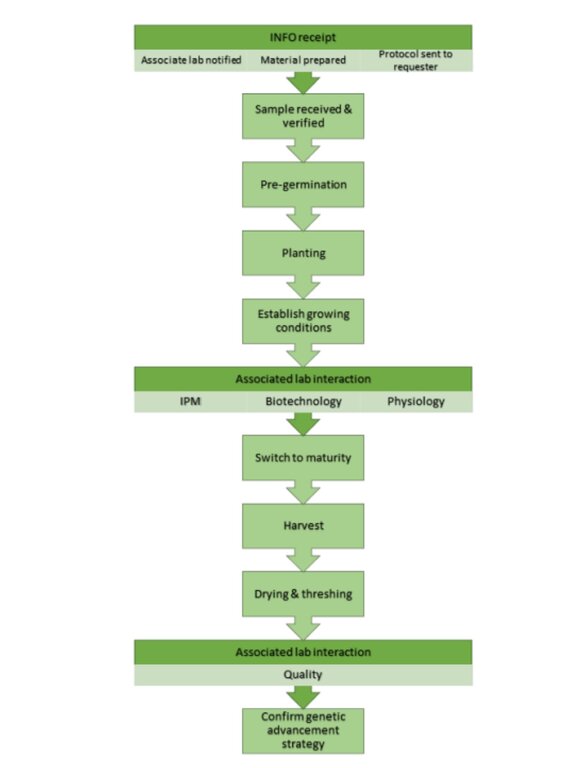Speed Breeding Platform [ប្រទេសម៉ារ៉ុក]
- ការបង្កើត៖
- បច្ចុប្បន្នភាព
- អ្នកចងក្រង៖ Joren Verbist
- អ្នកកែសម្រួល៖ –
- អ្នកត្រួតពិនិត្យច្រើនទៀត៖ William Critchley, Rima Mekdaschi Studer
approaches_6875 - ប្រទេសម៉ារ៉ុក
ពិនិត្យមើលគ្រប់ផ្នែក
ពង្រីកមើលទាំងអស់ បង្រួមទាំងអស់1. ព័ត៌មានទូទៅ
1.2 ព័ត៌មានលម្អិតពីបុគ្គលសំខាន់ៗ និងស្ថាប័នដែលចូលរួមក្នុងការវាយតម្លៃ និងចងក្រងឯកសារនៃវិធីសាស្ត្រផ្សព្វផ្សាយ
បុគ្គលសំខាន់ម្នាក់ (ច្រើននាក់)
Developed the Standard Operating Procedures of ICARDA Speed Breeding Platform:
Zaim M
International Center of Agricultural Research in Dry Areas (ICARDA)
ប្រទេសម៉ារ៉ុក
Speed Breeding Platform co-developer:
Morsli H
International Center of Agriculture Research in the Dry Areas (ICARDA)
ប្រទេសម៉ារ៉ុក
Physiologist:
Visioni M
International Center of Agricultural Research in Dry Areas (ICARDA)
ប្រទេសម៉ារ៉ុក
Entomologist:
Boulamtat R
International Center of Agricultural Research in Dry Areas (ICARDA)
ប្រទេសម៉ារ៉ុក
Pathologist:
Kemal S.A.
ប្រទេសម៉ារ៉ុក
Barley Breeder and Speed Breeding Platform designer:
Sanchez-Garcia M
International Center of Agricultural Research in Dry Areas (ICARDA)
ប្រទេសម៉ារ៉ុក
ឈ្មោះគម្រោងដែលបានចងក្រងឯកសារ/ វាយតម្លៃលើវិធីសាស្ត្រផ្សព្វផ្សាយ (បើទាក់ទង)
ICARDA Institutional Knowledge Management Initiativeឈ្មោះអង្គភាពមួយ (ច្រើន) ដែលបានចងក្រងឯកសារ/ វាយតម្លៃលើវិធីសាស្ត្រផ្សព្វផ្សាយ (បើទាក់ទង)
International Center for Agricultural Research in the Dry Areas (ICARDA) - ប្រទេសលីបង់1.3 លក្ខខណ្ឌទាក់ទងទៅនឹងការប្រើប្រាស់ទិន្នន័យដែលបានចងក្រងតាមរយៈវ៉ូខេត
តើពេលណាដែលទិន្នន័យបានចងក្រង (នៅទីវាល)?
2022
អ្នកចងក្រង និង(បុគ្គលសំខាន់ៗ)យល់ព្រមទទួលយកនូវលក្ខខណ្ឌនានាទាក់ទងទៅនឹងការប្រើប្រាស់ទិន្នន័យដែលបានចងក្រងតាមរយៈ វ៉ូខេត:
បាទ/ចា៎
2. ការពណ៌នាអំពីវិធីសាស្ត្រផ្សព្វផ្សាយ SLM
2.1 ពណ៌នាសង្ខេបខ្លីពីវិធីសាស្ត្រផ្សព្វផ្សាយ
Improving crop varieties is crucial for food security and climate resilience, but traditional methods are slow and expensive. The Speed Breeding Platform shortens breeding time substantially, enhances quality, and relies on strong partnerships between NARES and CGIAR centers.
2.2 ពណ៌នាលម្អិតពិវិធីសាស្ត្រផ្សព្វផ្សាយ
ពណ៌នាលម្អិតពិវិធីសាស្ត្រផ្សព្វផ្សាយ:
Climate change presents significant challenges for agriculture and crop production. One possible solution to enhance climate resilience is the development and adoption of improved, better adapted crop varieties. These varieties are specifically engineered to withstand specific threats, offering farmers a more reliable means of ensuring successful harvests despite the challenges posed by a changing climate. Improved varieties are thus crucial for achieving food security.
However, a major limitation of this solution is that researching and producing new crop varieties is a complex process that demands considerable time and resources. It involves cross design, segregating generation advancement and rigorous field testing to identify traits. The development of new varieties often spans several years, if not decades, before they are ready for widespread adoption by farmers. Sustained investment and collaboration across scientific organizations are thus crucial.
To accelerate the development of improved crop varieties, the International Center of Agricultural Research in Dry Areas (ICARDA), together with partners is implementing Speed Breeding as its main generation advancement method. Through the support of the Arab Fund for Economic and Social development (AFESD), the Templeton World Charity Foundation, Inc and the Crop Trust, protocols to accelerate the generation advancement of the main crops (wheat, barley, faba bean, lentil, grasspea and chickpea) have been developed and are available to NARES. ICARDA has also established the Speed Breeding Platform in Rabat, Morocco. Covering approximately 500 square meters, this facility comprises four buildings, including two greenhouses of 175 m2 and 185 m2 respectively, each housing five independently controlled growth chamber.i
The Speed Breeding method utilises LED lighting - originally invented by NASA to sustain astronauts during prolonged space missions to compensate for the absence of sunlight in space. By providing plants with approximately 22 hours of light per day, this accelerates their growth significantly. Cultivating crops in a controlled environment shields them from the unpredictable impacts of adverse weather conditions. The major advantage is thus its ability to accelerate the breeding process for improved crop varieties. For instance, while traditional methods may take between 6 and 12 years to breed a new grass pea (Lathyrus sativus) variety, utilizing the Speed Breeding Platform reduces this timeframe to approximately 5 years. The Speed Breeding Platform thus enhances efficiency and responsiveness in addressing agricultural challenges.
The Speed Breeding Platform has a capacity for advancing over 50,000 cereal and legume plants. This is done in close collaborations with fellow scientists from other CGIAR centers and National Agricultural Research and Extensions Services (NARES) centers. NARES centers play an indispensable role in determining the traits and varieties to prioritize for advancement, using their direct engagement with farmers in field settings to assess their specific needs and challenges. The main advantages are:
- Varieties reach farmers faster by reducing the time from crossing to field testing;
- Testing during advancement increases the resilience of new varieties to pests and diseases i.e., higher quality of improved varieties;
- It can help coordinating breeding action between CGIAR and NARES by co-designing crosses and centralizing advancement i.e., higher resource efficiency.
The main disadvantage is the high costs associated with building and operating the facilities of the Platform. In addition, it requires expertise to operate. However, NARES personnel are currently being trained and educated in breeding and using the Speed Breeding Platform.
In conclusion, while improved crop varieties hold immense potential for climate resilience in agriculture and ensuring food security, their development remains a complex, time-consuming and resource-intensive process. The approach of the Speed Breeding Platform represents a promising step forward, by faster and more efficient crop breeding, facilitating a prompter solution.
Acknowledgement: the pilot facilities used to set up the ICARDA Speed Breeding Platform were funded by a project from the Third Call for Proposals under the Benefit-sharing Fund of the International Plant Treat for Plant Genetic Resources for Food and Agriculture entitled “Addressing the challenges of climate change for sustainable food security in Turkey, Iran and Morocco, through the creation and dissemination of an international database to promote the use of wheat genetic resources and increase genetic gains.” CFP 2014/2015-W3B-PR-18-Turkey. The final facilities were funded by a project from the Arab Fund for Economic and Social Development (AFESD) entitled “Modernization of ICARDA Breeding Programs".
2.3 រូបភាពនៃវិធីសាស្ត្រផ្សព្វផ្សាយ
2.5 ប្រទេស/តំបន់/ទីតាំងកន្លែង ដែលវិធីសាស្ត្រផ្សព្វផ្សាយត្រូវបានអនុវត្តន៍
ប្រទេស:
ប្រទេសម៉ារ៉ុក
បញ្ជាក់បន្ថែមពីលក្ខណៈនៃទីតាំង:
Rabat
Map
×2.6 កាលបរិច្ឆេទនៃការចាប់ផ្តើម និងបញ្ចប់នៃវិធីសាស្រ្តផ្សព្វផ្សាយនេះ
សូមបញ្ជាក់ឆ្នាំដែលបានបង្កើតឡើង:
2021
2.7 ប្រភេទនៃវិធីសាស្ត្រផ្សព្វផ្សាយ
- ផ្អែកលើគម្រោង/កម្មវិធី
2.8 គោលបំណង/ទិសដៅសំខាន់នៃវិធីសាស្ត្រផ្សព្វផ្សាយ
The objective of the new Speed Breeding Platform is to provide the tools to CGIAR and NARES breeding programs to develop better varieties faster and shorten the time needed to reach farmer’s fields. The access to this technology also helps responding to new threats hindering productivity in a faster and more effective way.
2.9 លក្ខខណ្ឌអនុញ្ញាត ឬរារាំងការអនុវត្តន៍បច្ចេកទេសដែលស្ថិតនៅក្រោមវិធីសាស្រ្តផ្សព្វផ្សាយ
ភាពអាចរកបាននៃធនធានហិរញ្ញវត្ថុ និងសេវាកម្ម
- រារាំង
Developing this type of facilities require an important initial investment and more importantly a considerable running cost.
បរិបទនៃស្ថាប័ន
- អំណោយផល
The leading institution, in this case ICARDA, realized the potential for impact of this technology for the region and initiated the fund raising to make it happen.
ការសហការ/ការសម្របសម្រួលតួអង្គពាក់ព័ន្ធ
- អំណោយផល
The use of this technology will involve the coordination between ICARDA Speed Breeding Platform personnel, ICARDA breeders and NARES breeders to decide the best approach to have a collaborative use of the facilities.
ចំណេះដឹងស្តីពី SLM និងការទទួលបានការគាំទ្រផ្នែកបច្ចេកទេស
- រារាំង
This technology requires not only the adequate facilities but also the know-how. ICARDA has developed a Standard Operations Procedure that summarizes the know-how and it is freely available as international public good.
ទំហំការងារ ភាពអាចរកបាននៃកម្លាំងពលកម្ម
- រារាំង
The use of the technology requires well trained manpower to effectively achieve a high number of generations per year.
3. ការចូលរួម និងតួនាទីរបស់ភាគីពាក់ព័ន្ធ
3.1 អ្នកពាក់ព័ន្ធដែលបានចូលរួមក្នុងវិធីសាស្ត្រផ្សព្វផ្សាយ និងតួនាទីរបស់ពួកគេ
- អ្នកស្រាវជ្រាវ
CGIAR, ICARDA, and NARES breeders
They decide the plant populations to be advanced and the type of testing involved.
- អង្គការអន្តរជាតិ
AFESD and FAO
The Benefit Sharing fund of the ITPGR (FAO) funded the growth chamber that was later used as pilot chamber to adapt and test the technology. Then, AFESD through the Breeding Modernization of ICARDA Breeding Programs provided the funds to build the new facilities.
ប្រសិនមានភាគីពាក់ព័ន្ធច្រើនចូលរួមសូមចង្អុលបង្ហាញភ្នាក់ងារដែលនាំមុខគេ:
ICARDA
3.2 ការចូលរួមរបស់អ្នកប្រើប្រាស់ដីក្នុងតំបន់/ សហគមន៍ក្នុងតំបន់ក្នុងដំណាក់កាលផ្សេងគ្នានៃវិធីសាស្រ្តផ្សព្វផ្សាយ
| ការចូលរួមរបស់អ្នកប្រើប្រាស់ដីក្នុងតំបន់/សហគមន៍ក្នុងតំបន់ | សូមបញ្ជាក់នរណាត្រូវបានចូលរួម ព្រមទាំងពណ៌នាសកម្មភាពទាំងនោះ | |
|---|---|---|
| ការចាប់ផ្តើម/ការលើកទឹកចិត្ត | អសកម្ម | |
| ការរៀបចំផែនការ | អសកម្ម | |
| ការអនុវត្តន៍ | អសកម្ម | |
| ការត្រួតពិនិត្យ និងវាយតម្លៃ | អសកម្ម |
3.3 គំនូសបំព្រួញ (ប្រសិនបើមាន)
ការពណ៌នា:
1: Receive information from requester (including material description, advancing strategy, traits, germplasm)
2: Receive and check samples: ICARDA Speed Breeding Platform staff inspect the samples prior to placing them in ICARDA Speed Breeding Platform Store 1 to identify and
address potential pests and other problems. Then, the samples are kept at -20°C for 24h to eliminate potential insect pests in the seeds.
3: Pre-germination: seeds are placed on the trays with systematic labeling. The results of pre-germination process are reported to the requester.
4: Growing conditions: The establishment of the growing conditions will depend on the crop and type of selection strategy applied.
5: Planting and transfer to growth room: Once the scientist confirms the planting list, the staff start planting on cones following the agreed protocol.
6: Trait collection: the facility manager will notify one week in advance the concerned labs when the plants are reaching the key growing stage set in the Project Protocol for trait recording or leaf sampling. Before maturity, the relevant disciplines are IPM, physiology and biotechnology. For traceability and data safety, data are recorded via Fieldbook Android Application, to be imported to BMS via BrApi.
7: Switch to maturity mode : After flowering the plants will enter the accelerated maturity process as per the protocols. Thus, the irrigation is stopped to force plant maturity. The requester will be notified of the entries with missing spikes or pods. At this stage, the FM will inform the quality lab to prepare for the reception of samples if established in the Project Protocol.
8. Harvest: The ICARDA Speed Breeding Platform staff harvest the plants following the requester selection (if any). The harvested spikes/pods are put in labeled bags showing: Crop, trial name, harvesting date, entry code and the barcode.
9. Drying and threshing: The harvested plants are placed in ovens for 2 days at 45°C, then threshed. If the Project Protocol includes it, the seeds are sent to the quality lab for end-use quality analysis. Otherwise, the seeds are kept in Store 1 for short term storage. The facility manager communicates the seed number of each entry to the requester, together with all recorded data.
10. Generation advancement strategy: Based on the data collected during the experiment, the requester confirms the next step of the genetic advancement strategy. In case a selection is made, the requester provides the required information by adding the information to the request form and send it to the RS to generate a new Project Protocol.
អ្នកនិពន្ធ:
ICARDA Cereals and Legumes Speed Breeding Platform ( https://hdl.handle.net/20.500.11766/67537 )
3.4 ការសម្រេចចិត្តលើការជ្រើសរើសបច្ចេកទេស SLM
សូមបញ្ជាក់តើអ្នកណាជាអ្នកបានសម្រេចចិត្តក្នុងការជ្រើសរើសបច្ចេកទេសដើម្បីយកមកអនុវត្តន៍:
- អ្នកជំនាញឯកទេស SLM តែឯង
សូមបញ្ជាក់ តើការសម្រេចធ្វើឡើងដោយផ្អែកលើអ្វីជាមូលដ្ឋាន:
- លទ្ធផលបានពីការស្រាវជ្រាវ
4. ជំនួយបច្ចេកទេស ការកសាងសមត្ថភាព និងការគ្រប់គ្រងចំណេះដឹង
4.1 ការកសាងសមត្ថភាព/ បណ្តុះបណ្តាល
តើវគ្គបណ្តុះបណ្តាលបានផ្តល់ឱ្យអ្នកប្រើប្រាស់ដី/អ្នកពាក់ព័ន្ធផ្សេងៗទៀតដែរឬទេ?
បាទ/ចា៎
- Researchers and breeders
ទម្រង់នៃការបណ្តុះបណ្តាល:
- អនុវត្តន៍ជាមួយការងារ
- វគ្គបណ្តុះបណ្តាល
ប្រធានបទបណ្តុះបណ្តាល:
Breeding
4.2 សេវាផ្តល់ប្រឹក្សាយោបល់
តើអ្នកប្រើប្រាស់ដីបានទទួលនូវសេវាផ្តល់ប្រឹក្សាដែរ ឬទេ?
បាទ/ចា៎
សូមបញ្ជាក់ប្រសិនបើសេវាកម្មប្រឹក្សាយោបល់ត្រូវបានផ្តល់ឱ្យ:
- នៅលើដីរបស់អ្នកប្រើប្រាស់ដី
- នៅមជ្ឈមណ្ឌលជាអចិន្ត្រៃ
4.3 ការពង្រឹងសមត្ថភាពស្ថាប័ន (ការអភិរឌ្ឍន៍អង្គភាព)
តើស្ថាប័នទាំងអស់ត្រូវបានបង្កើតឡើង ឬពង្រឹងសមត្ថភាពតាមរយៈវិធីសាស្ត្រផ្សព្វផ្សាយដែរ ឬទេ?
- បាទ/ច៎ា តិចតួច
សូមបញ្ជាក់ថាតើស្ថាប័នត្រូវបានពង្រឹង ឬបង្កើតឡើងនៅត្រឹមកម្រិតណា(ច្រើន)?
- កម្រិតថ្នាក់ជាតិ
សូមបញ្ជាក់ប្រភេទនៃការគាំទ្រ:
- ការកសាងសមត្ថភាព/ បណ្តុះបណ្តាល
សូមផ្តល់ព័ត៌មានបន្ថែមទៀតឱ្យបានលម្អិត:
National scientists are trained in breeding and using the Speed Breeding Platform
4.4 ការត្រួតពិនិត្យ និងវាយតម្លៃ
តើការត្រួតពិនិត្យ និងវាយតម្លៃគឺជាផ្នែកមួយនៃវិធីសាស្ត្រដែរឬទេ?
ទេ
4.5 ការស្រាវជ្រាវ
តើការស្រាវជ្រាវ គឺជាផ្នែកមួយនៃវិធីសាស្រ្តដែរឬទេ?
បាទ/ចា៎
- Genetics / Breeding
សូមផ្តល់ព័ត៌មានបន្ថែមទៀតឱ្យបានលម្អិត និងចង្អុលបង្ហាញនរណាដែលបានធ្វើការស្រាវជ្រាវ:
Research in breeding is done by ICARDA, CGIAR centers and NARES centers
5. ថវិកា និងសម្ភារៈឧបត្ថម្ភពីខាងក្រៅ
5.1 ថវិកាប្រចាំឆ្នាំសម្រាប់ផ្សព្វផ្សាយ SLM
ប្រសិនបើចំនួនពិតប្រាកដនៃថវិកាប្រចាំឆ្នាំមិនត្រូវបានដឹងច្បាស់ សូមប្រាប់ពីចន្លោះនៃថវិកានោះ:
- 100,000-1,000,000
មតិយោបល់ (ឧ. ប្រភពសំខាន់នៃមូលនិធិ/ម្ចាស់ជំនួយចំបង):
The main donors were the Benefit Sharing Fund of the ITPGR (FAO) that provided the funding that resulted in the first Speed Breeding pilot facility with capacity for 3,000 plants and the Arab Fund for Economic and Social Development (AFESD) who provided the funds for the expansion of this initial pilot facility and develop the ICARDA Speed Breeding Platform, a fully automatic facility that allows advancing more than 50,000 cereal and legume plants
5.2 ការគាំទ្រផ្នែកហិរញ្ញវត្ថុ / សម្ភារៈដែលបានផ្តល់ទៅឱ្យអ្នកប្រើប្រាស់ដី
តើអ្នកប្រើប្រាស់ដីបានទទួលការគាំទ្រផ្នែកហិរញ្ញវត្ថ/សម្ភារៈសម្រាប់ការអនុវត្តន៍បច្ចេកទេសដែរឬទេ:
ទេ
5.3 សូមបញ្ជាក់ពីធាតុចូលត្រូវបានផ្តល់បដិភាគ (រួមទាំងកម្លាំងពលកម្ម)
- គ្មាន
5.4 ឥណទាន
តើឥណទានដែលបានផ្តល់នៅក្រោមវិធីសាស្ត្រផ្សព្វផ្សាយសម្រាប់សកម្មភាព SLM នេះយ៉ាងដូចម្តេច?
ទេ
5.5 ការលើកទឹកចិត្ត ឬវិធីសាស្ត្រដ៏ទៃទៀត
តើមានការលើកទឹកចិត្តផ្សេងទៀត ឬឧបករណ៍ប្រើប្រាស់ដើម្បីលើកកម្ពស់ការអនុវត្តន៍បច្ចេកទេស SLM?
ទេ
6. ការវិភាគរកផលប៉ះពាល់ និងសេចក្តីសន្និដ្ឋាន
6.1 ផលប៉ះពាល់នៃវិធីសាស្ត្រផ្សព្វផ្សាយ
តើវិធីសាស្ត្រផ្សព្វផ្សាយជួយអ្នកប្រើប្រាស់ដីដើម្បីអនុវត្តន៍ និងថែទាំបច្ចេកទេស SLM?
- ទេ
- បាទ/ច៎ា បន្តិចបន្តួច
- បាទ/ច៎ា ជាមធ្យម
- បាទ/ច៎ា បានខ្លាំង
Through the Speed Breeding Platform, improved varieties are publicly released to farmers and seed cooperation. This allows them to use their land more sustainable.
តើវិធីសាស្រ្តផ្សព្វផ្សាយនេះធ្វើឱ្យប្រសើរឡើងនូវការសម្របសម្រួលនិងការអនុវត្តចំណាយរបស់ SLMមានប្រសិទ្ធិភាពបែបណា? :
- ទេ
- បាទ/ច៎ា បន្តិចបន្តួច
- បាទ/ច៎ា ជាមធ្យម
- បាទ/ច៎ា បានខ្លាំង
Building on strong collaboration between international partners and national partners, breeding became more centralized making it more cost-effective. The reduced breeding time also contributes to higher resource efficiency.
តើវីធីសាស្ត្រផ្សព្វផ្សាយនេះពង្រឹងចំណេះដឹង និងកសាងសមត្ថភាពរបស់អ្នកពាក់ព័ន្ធឬទេ?
- ទេ
- បាទ/ច៎ា បន្តិចបន្តួច
- បាទ/ច៎ា ជាមធ្យម
- បាទ/ច៎ា បានខ្លាំង
Staff of NARES centers are trained in breeding.
តើវីធីសាស្ត្រនេះបានជួយកសាង/ពង្រឹងស្ថាប័ន កិច្ចសហប្រតិបត្តិការរវាងអ្នកពាក់ព័ន្ធដែរ ឬទេ?
- ទេ
- បាទ/ច៎ា បន្តិចបន្តួច
- បាទ/ច៎ា ជាមធ្យម
- បាទ/ច៎ា បានខ្លាំង
Staff of NARES centers are trained in breeding.
តើវិធីសាស្ត្រផ្សព្វផ្សាយនាំឱ្យប្រសើរឡើងនូវសន្តិសុខស្បៀង/ធ្វើឱ្យប្រសើរឡើងនូវអាហាររូបត្ថម្ភ?
- ទេ
- បាទ/ច៎ា បន្តិចបន្តួច
- បាទ/ច៎ា ជាមធ្យម
- បាទ/ច៎ា បានខ្លាំង
Improved varieties are more climate resilient contributing to food security.
តើវិធីសាស្ត្របានធ្វើឱ្យប្រសើរឡើងនូវការកសាងសមត្ថភាពរបស់អ្នកប្រើប្រាស់ដីដើម្បីបន្សុំាទៅនឹងការប្រែប្រួលអាកាសធាតុ/អាកាសធាតុក្តៅហែង និងកាត់បន្ថាយគ្រោះមហន្តរាយទាក់ទឹងនឹងអាកាសធាតុ?
- ទេ
- បាទ/ច៎ា បន្តិចបន្តួច
- បាទ/ច៎ា ជាមធ្យម
- បាទ/ច៎ា បានខ្លាំង
Improved varieties are better adapted to the changing climate.
6.2 ការលើកទឹកចិត្តចម្បងៗរបស់អ្នកប្រើប្រាស់ដីសម្រាប់ការអនុវត្តបច្ចេកទេស SLM
- បង្កើនផលិតកម្ម
- បង្កើនប្រាក់ចំណេញ (សមត្ថភាព) បង្កើនអត្រាចំណេញ
- កាត់បន្ថយហានិភ័យនៃគ្រោះមហន្តរាយ
6.3 សកម្មភាពផ្សព្វផ្សាយដែលប្រកបដោយចីរភាព
តើអ្នកប្រើប្រាស់ដីអាចធ្វើឱ្យមានចីរភាពនូវអ្វីដែលត្រូវបានអនុវត្តន៍តាមរយៈវិធីសាស្ត្រផ្សព្វផ្សាយដែរឬទេ(ដោយពុំមានការគាំទ្រពីអ្នកខាងក្រៅ)?
- មិនប្រាកដ
6.4 ភាពខ្លាំង/ គុណសម្បត្តិនៃវិធីសាស្ត្រផ្សព្វផ្សាយ
| ភាពខ្លាំង/ គុណសម្បត្តិ/ ឱកាស ទស្សនៈរបស់អ្នកប្រើប្រាស់ដី |
|---|
| Varieties reach farmers faster by reducing the time from crossing to field testing |
| Allows testing during advancement increasing the resilience of new varieties to pests and diseases |
| Can help coordinating breeding action between CGIAR and NARES by co-designing crosses and centralizing advancement |
6.5 ភាពខ្សោយ/ គុណវិបត្តិនៃវិធីសាស្ត្រ និងរកដំណោះស្រាយ
| ភាពខ្សោយ/ គុណវិបត្តិ/ ហានិភ័យ ទស្សនៈរបស់អ្នកប្រើប្រាស់ដី | តើបច្ចេកទេសទាំងនោះបានដោះស្រាយបញ្ហាដូចម្តេច? |
|---|---|
| Relatively high initial investment to develop the facilities | ICARDA platform is open to NARES and other collaborators hence costs can be shared. |
| Expertise is needed to achieve results | Code of conducts and protocols of the facilities has been published and trainings of NARES staff are being done. |
7. ឯកសារយោង និងវេបសាយ
7.1 វិធីសាស្ត្រ/ ប្រភពនៃព័ត៌មាន
- ការសម្ភាសន៍ជាមួយអ្នកជំនាញ/ ឯកទេស
- ការចងក្រងពីរបាកការណ៍ និងឯកសារផ្សេងៗទៀតដែលមាន
7.3 ចូលទៅទាញយកឯកសារពាក់ព័ន្ធដែលមានលើបណ្តាញអ៊ិនធឺណែត
ចំណងជើង/ ពណ៌នា:
ICARDA Cereals and Legumes Speed Breeding Platform.
វេបសាយ:
https://mel.cgiar.org/reporting/downloadmelspace/hash/186eb1d94780ca956e9b86227305761a/v/7ec567b72097f21057ea41b0124cf1a7
ចំណងជើង/ ពណ៌នា:
Laura Becker, Enrico Bonaiuti, Miguel Sanchez-Garcia, Zakaria Kehel, Andrea Visioni, Ajit Govind. (1/12/2020). Monitoring, Evaluation, and Learning Plan for Modernization of Crop Breeding Programs in Arab Countries.
វេបសាយ:
https://hdl.handle.net/20.500.11766/12212
ចំណងជើង/ ពណ៌នា:
Miguel Sanchez-Garcia, Zewdie Bishaw, Abdoul Aziz Niane. (31/12/2021). 2022 ICARDA global barley breeding program International Nurseries. Beirut, Lebanon: International Center for Agricultural Research in the Dry Areas (ICARDA).
វេបសាយ:
https://hdl.handle.net/20.500.11766/66860
ចំណងជើង/ ពណ៌នា:
Samira El-Hanafi, Souad Cherkaoui, Zakaria Kehel, Miguel Sanchez-Garcia, Jean-Benoit Sarazin, P. Stephen Baenziger, Wuletaw Tadesse. (14/2/2022). Hybrid Seed Set in Relation with Male Floral Traits, Estimation of Heterosis and Combining Abilities for Yield and Its Components in Wheat (Triticum aestivum L. ). Plants, 11 (4).
វេបសាយ:
https://hdl.handle.net/20.500.11766/67050
ការតភ្ជាប់ និងម៉ូឌុល
ពង្រីកមើលទាំងអស់ បង្រួមទាំងអស់ការតភ្ជាប់
គ្មានការតភ្ជាប់
ម៉ូឌុល
គ្មានម៉ូឌុល


